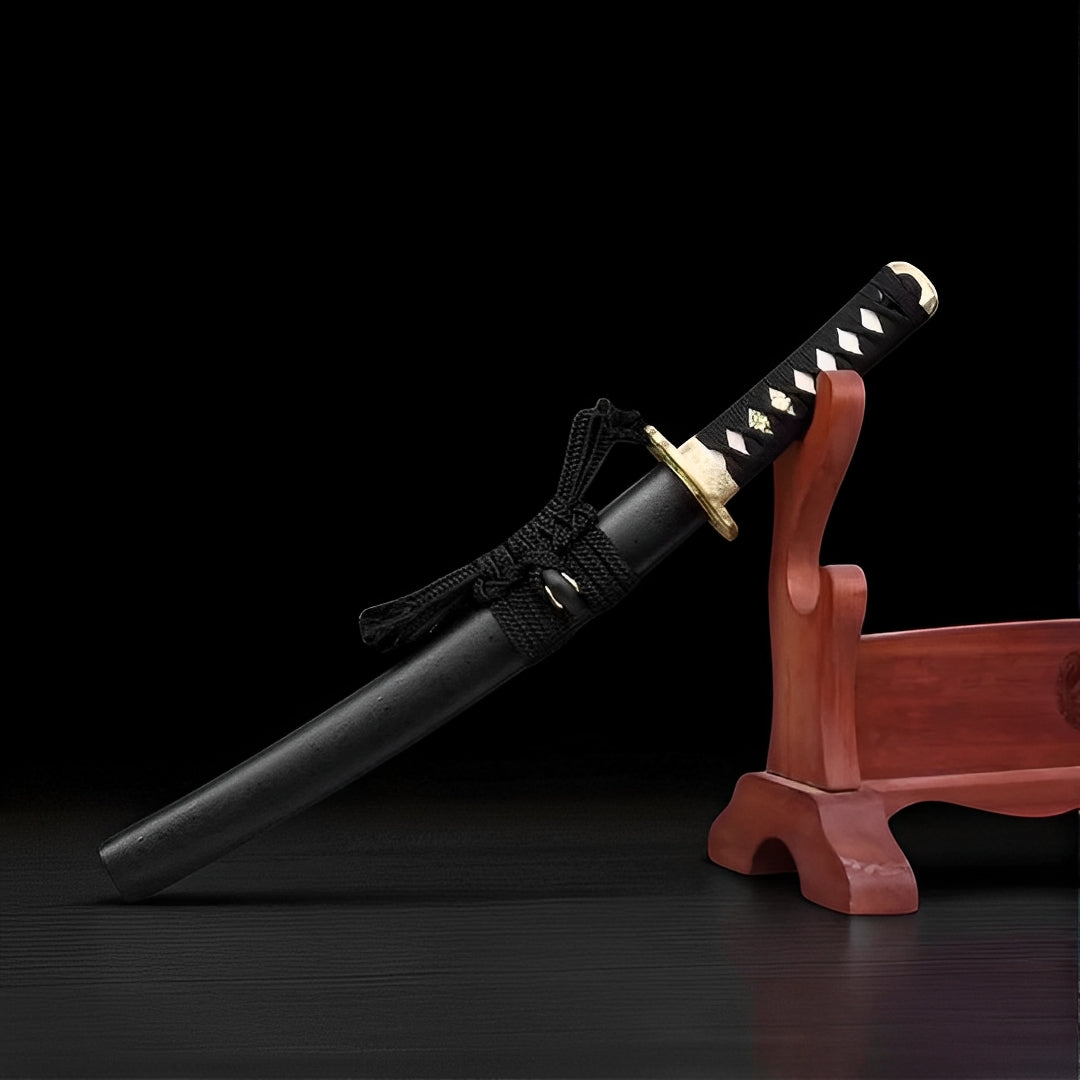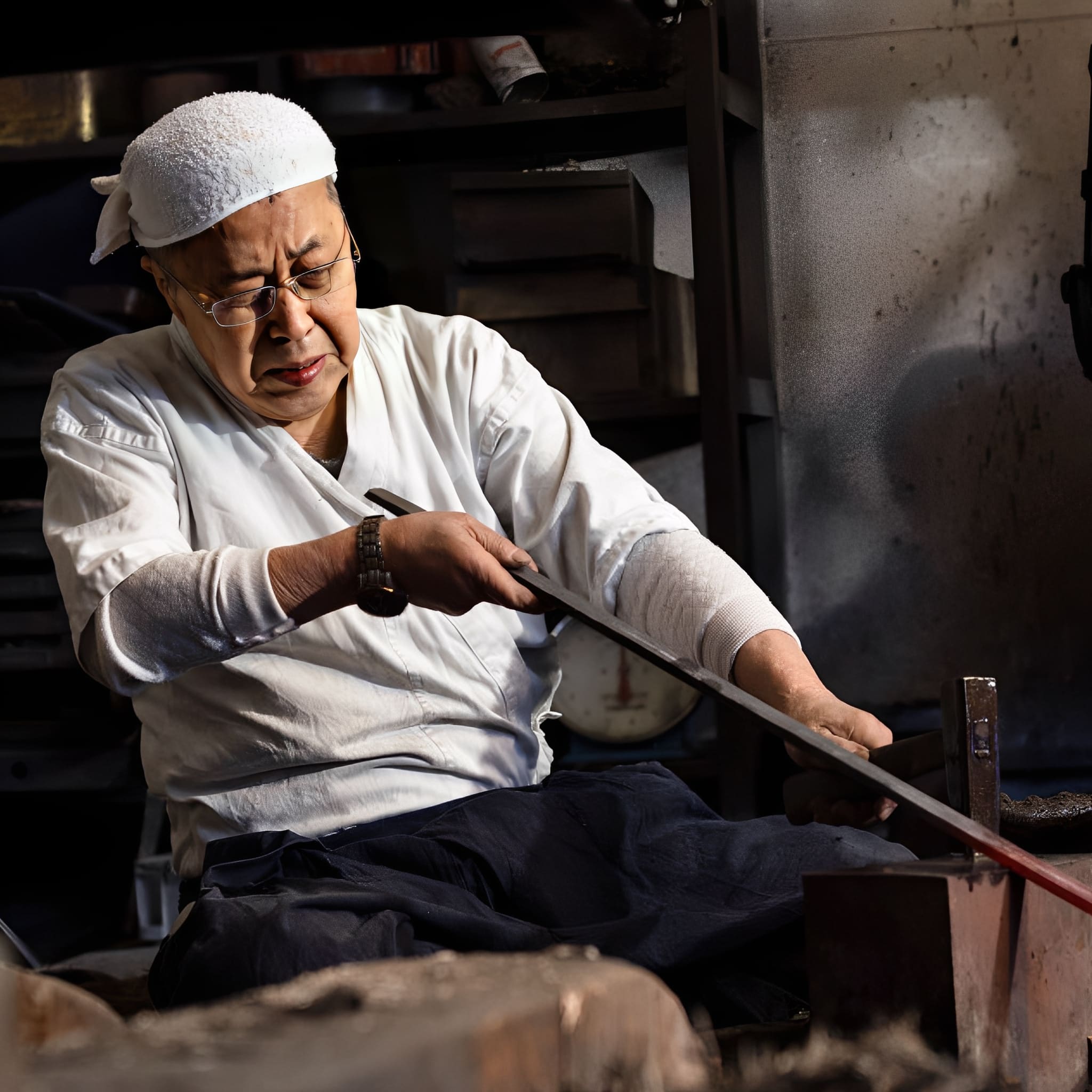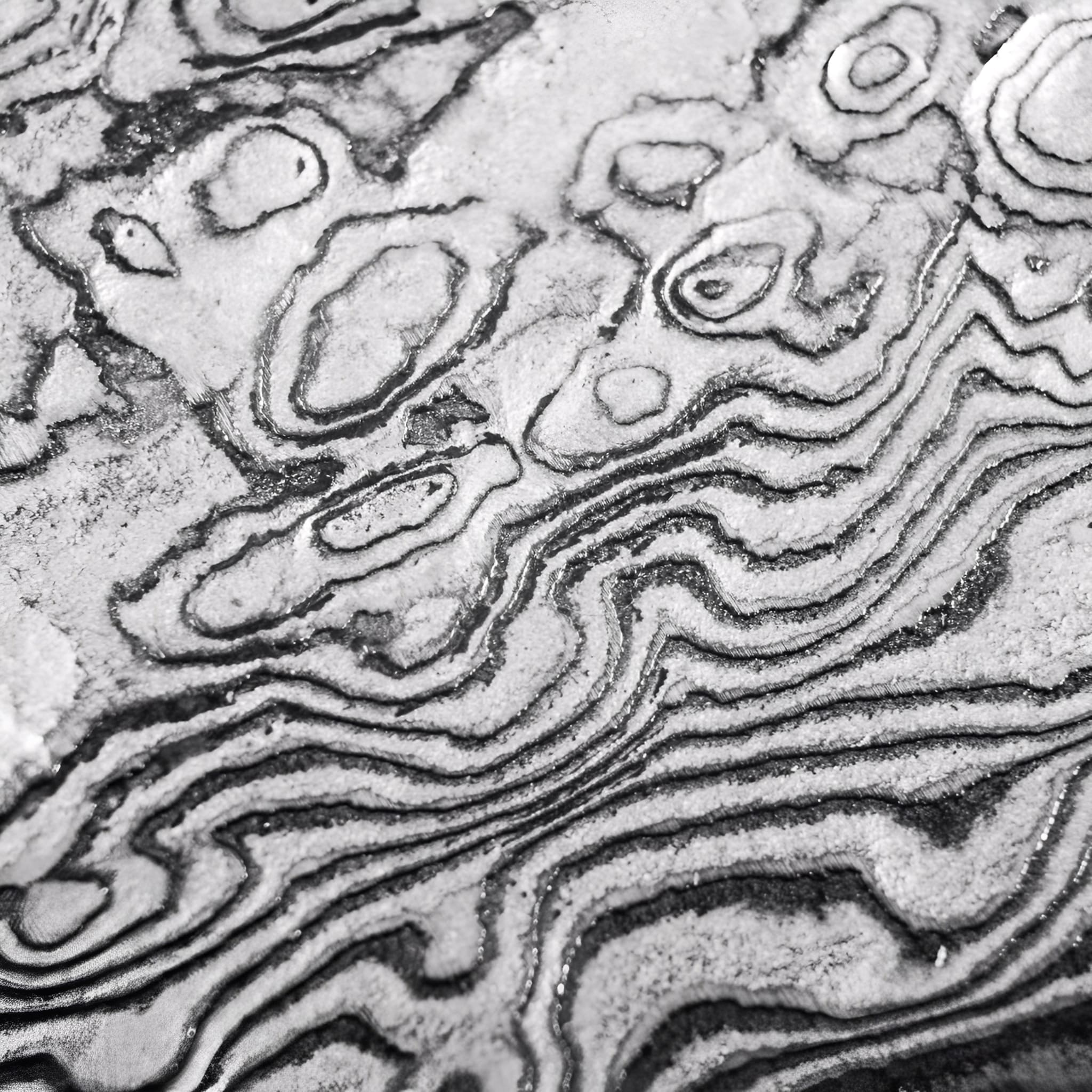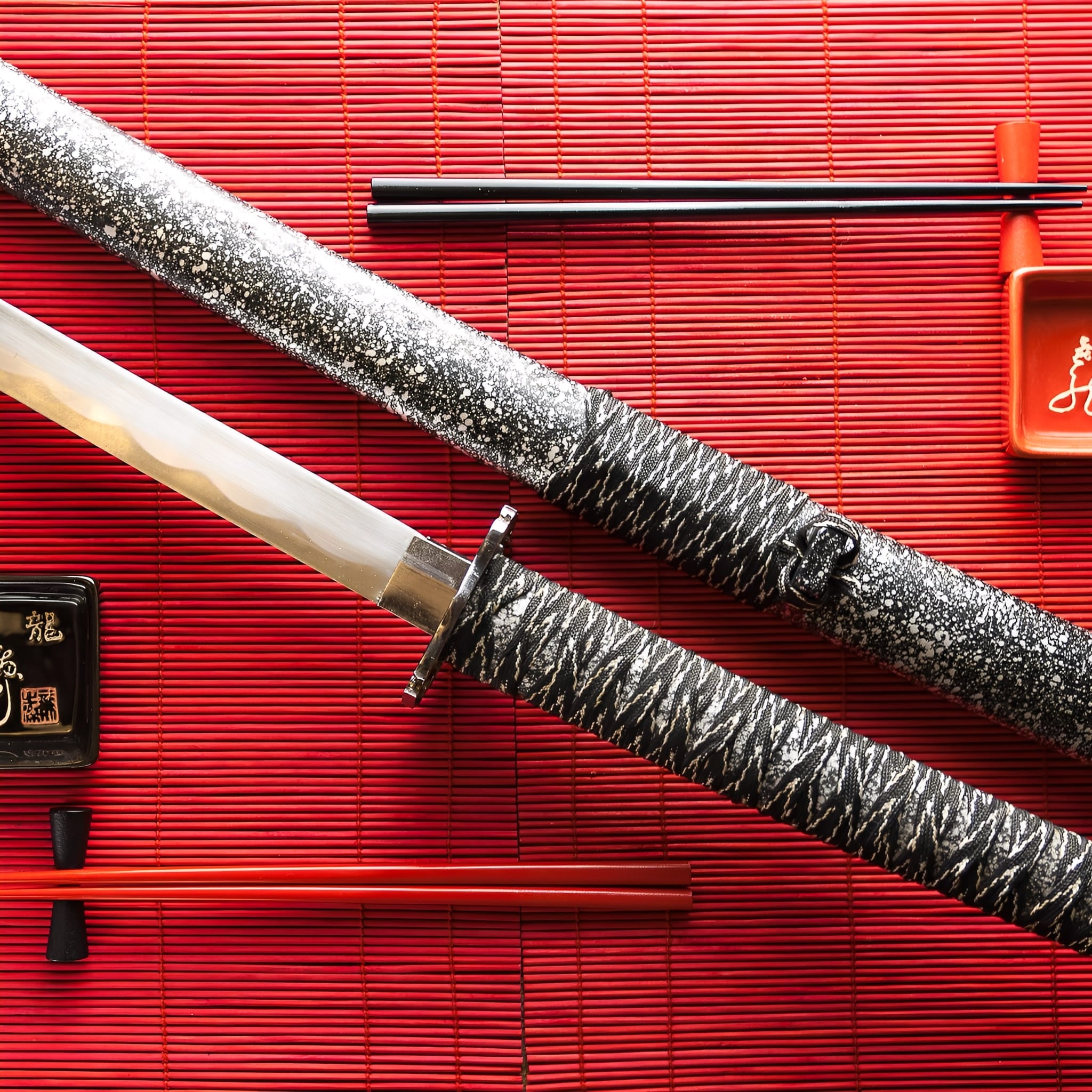Refund Guaranteed

Why choose us
Ships within 48/72h
Forged Blade
Collector Quality
Trusted Globally
Inspired by Japan
Hagane Tanto (Damascus Steel) - 破金短
Popular upgrades
Free Shipping over $250
No Bots, No AI
Refund Guaranteed
Free Shipping over $250
No Bots, No AI
Our team is here to help with any questions or concerns.
We’re always happy to assist you — don’t hesitate to reach out.
Why choose us
Ships within 48/72h
Forged Blade
Collector Quality
Trusted Globally
Inspired by Japan

Hagane Tanto (Damascus Steel) - 破金短
Specifications
- Handcrafted
- SHARP blade
- Blade: Damascus steel
- Genuine clay-tempered hamon
- Habaki made of brass
- Synthetic ray skin on the tsuka
- Copper tsuba
- Black silk ITO wrapping
- Solid wood saya
- Thick black sageo cord
- Kojiri, Fuchi & Kashira made of iron
- Full tang in the handle
- Total length: 50 cm
- Blade length: 33 cm
- Blade width: 3.2 cm
- Blade thickness: 0.7 cm
-
Handle length: 16 cm
Hagane Tanto - Damascus Steel Shadow Blade
Discover steel artistry refined through fire with the Hagane Tanto, where centuries-old Damascus forging techniques create hypnotic patterns invisible until drawn. This premium Japanese short sword conceals extraordinary craftsmanship beneath elegant black saya, revealing folded steel mastery only to those who earn the privilege of unsheathing - a blade that guards its beauty as jealously as samurai guarded their honor.
Damascus Steel Mastery
The soul of this Damascus steel tanto lies in its blade pattern - countless layers of high-carbon steel folded repeatedly during forging, creating swirling patterns that seem to flow like water or wood grain. These aren't decorative etchings but structural reality: each visible line represents distinct steel layers fused through hammer strikes, heat, and master craftsman expertise.
Damascus steel originated along ancient trade routes where bladesmiths discovered that folding different steel types created superior edge retention, flexibility, and breathtaking aesthetics simultaneously. Japanese smiths adapted these techniques into their own forging traditions, creating blades that balanced cutting performance with visual poetry.
The folding process removes impurities while distributing carbon content evenly, resulting in steel that holds edges longer than single-composition blades. But beyond function, the layered patterns make each folded steel blade absolutely unique - no two Damascus tantos display identical swirls, making every piece singular artwork.
When light catches the polished blade surface at proper angles, the Damascus pattern emerges like secret message written in steel - dark waves contrasting with brighter layers, organic shapes suggesting natural elements frozen mid-flow. This reveal moment transforms unsheathing from mere function into ceremonial unveiling.
Shadow Elegance Design
The completely black saya and mounting create mysterious elegance that distinguished warriors favored. Unlike ornate decorations announcing wealth, this premium tanto speaks through restraint - letting material quality and proportional perfection communicate value without shouting.
Traditional black ito wrapping follows authentic diamond pattern, its texture providing secure grip while maintaining monochrome sophistication. The wrapping technique requires precision; each crossing must align perfectly, each tension remain consistent. Flawed wrapping reveals itself immediately to educated eyes.
The brass tsuba guard provides sole metallic accent - warm gold tone creating visual anchor between black handle and hidden blade. This single point of contrast demonstrates Japanese aesthetic principle: one strategic highlight impacts more powerfully than scattered decoration.
White menuki ornaments peek subtly through ito wrapping, their cream tone breaking black monotony just enough to prevent visual heaviness. These small details reward close examination while maintaining overall restraint.
The black sageo cord wraps the saya with traditional knot work, serving both practical carry function and aesthetic completion. Quality sageo should feel substantial yet supple, maintaining knots without constant adjustment.
Heritage of Folded Steel
Damascus steel tanto represents pinnacle of traditional bladesmithing - the technique samurai swordsmiths spent lifetimes perfecting. Creating genuine folded steel requires understanding metallurgy at intuitive level, reading color changes during heating, knowing exactly when steel reaches perfect temperature for folding.
Historical samurai valued Damascus tanto as treasured possessions, often passing them through generations as family heirlooms. The distinctive patterns served as maker signatures; experienced warriors could identify famous smiths by recognizing their characteristic folding styles.
This traditional short sword follows authentic tanto geometry refined over centuries. The thick spine provides strength for parrying, the single sharp edge concentrates cutting power, and the angular tip penetrates with minimal resistance. These proportions haven't changed because they represent optimal balance between all required characteristics.
Warriors carried tanto constantly, tucking them into obi sashes where they remained accessible regardless of activity. Unlike katana reserved for formal occasions or battlefield, tanto stayed present during meals, sleep, negotiations - the most intimate blade in samurai arsenal.
Refined Collection Centerpiece
This collector tanto elevates any serious Japanese weapon collection. The mysterious all-black presentation creates anticipation - viewers know extraordinary craftsmanship hides within, but the blade reveals itself only when owner chooses. This element of concealed excellence appeals to collectors who appreciate subtlety over ostentation.
Display options abound: present in closed saya on traditional stands to emphasize elegant lines, or partially unsheathe to hint at Damascus patterns within. The black aesthetic works beautifully in modern minimalist interiors or traditional Japanese room settings equally well.
Perfect for martial arts practitioners studying authentic weapon forms, collectors specializing in Damascus steel blades, interior designers seeking sophisticated cultural artifacts, or anyone who understands that greatest beauty sometimes waits hidden until proper moment arrives.
The included wooden stand complements the tanto's refined character, providing stable display platform that doesn't compete visually with the blade's restrained elegance.
Care Instructions: Clean blade immediately after handling. Apply thin mineral oil coating before returning to saya. Store horizontally in stable temperature environment. Never leave blade in saya long-term without periodic inspection - traditional wood saya can retain moisture. Regular maintenance preserves Damascus pattern clarity.
True craftsmanship needs no announcement. The Hagane Tanto speaks through steel.
Legal Disclaimer
By purchasing from Katana Corp, you acknowledge and agree that:
- You are at least 18 years of age (or the age of majority in your jurisdiction).
- You are solely responsible for verifying and complying with all local laws and import regulations before placing an order.
- Some countries prohibit the importation of swords entirely. Katana Corp is not responsible for orders delayed, seized, or refused by customs authorities.
- All katanas and related products are sold strictly as decorative and display items. They are not intended or certified for combat use.
- Depending on the jurisdiction, swords may legally be considered bladed weapons, subject to specific restrictions or prohibitions.
- Katana Corp disclaims all liability for any injury, damage, or legal consequences resulting from misuse, abuse, or unlawful use of its products.
For full details, please refer to our Terms of Service.
Care & Maintenance
To maintain your katana's appearance and performance over time, we recommend:
- Regularly wiping the blade with a soft cloth to remove fingerprints and moisture.
- Applying a light coat of choji oil to prevent rust (for carbon steel blades).
- Storing the sword in a dry place, preferably inside its saya.
- Avoiding direct contact with hard surfaces to preserve sharpness and finish.
For more care tips, check our full maintenance guide in the FAQ section.
Behind the Blade
Every katana we offer carries the essence of centuries-old craftsmanship.
More than just a weapon, the katana symbolizes discipline, honor, and mastery.
Our artisans draw inspiration from traditional forging methods to ensure each blade reflects the spirit of the samurai — strength, precision, and soul.
Owning one is not just about aesthetics — it’s about carrying a piece of that legacy.
User Experience
This katana is designed to offer a perfect balance between blade and handle.
Its ergonomic tsuka (handle) allows a secure two-handed grip, while the weight distribution ensures smooth, fluid movement.
Whether for training, display or cutting practice, handling feels natural and precise.

The Art of Traditional Forging
Each katana we craft is born from centuries of samurai tradition.
Our master smiths shape every blade by hand, folding the steel to achieve unmatched strength, flexibility, and beauty.
This time-honored process is not just about creating a weapon? it’s about preserving a legacy of discipline, honor, and artistry.

Materials Chosen Without Compromise
We select only the highest-grade steels and authentic fittings to ensure every katana is both a masterpiece and a reliable companion.
From the flawless hamon line to the perfectly balanced tang, each detail is carefully inspected to meet the highest standards of performance and aesthetics.

More Than a Sword, A Lifelong Legacy
Owning a handmade katana is an experience that goes beyond the blade itself. It’s holding history, tradition, and craftsmanship in your hands.
Whether displayed as a work of art or wielded with precision, your katana will stand as a symbol of timeless skill and dedication for generations to come.
-
Key Destinations
United States: 5–7 days
Canada: 5–7 days
Australia: 6–9 days
Denmark: 4–6 days
Netherlands: 3–5 days
Sweden: 4–6 days
Switzerland: 3–5 days
Finland: 5–7 days
Singapore: 6–8 days -
Central European Partners
France: 2–3 days
Germany: 3–5 days
Spain: 4–6 days
Italy: 4–6 days
Belgium: 3–5 days
Austria: 4–6 days
Ireland: 4–6 days
Poland: 4–6 days
Portugal: 4–6 days -
Extended EU Network
Czechia: 4–6 days
Hungary: 4–6 days
Slovakia: 4–6 days
Slovenia: 5–7 days
Romania: 5–7 days
Bulgaria: 5–7 days
Croatia: 5–7 days
Serbia: 5–7 days
Estonia: 5–7 days
Latvia: 5–7 days
Lithuania: 5–7 days
Luxembourg: 3–5 days
Greece: 5–8 days -
FAQ’s
Visit our FAQs page to find answers to common questions.